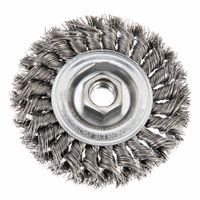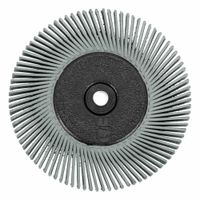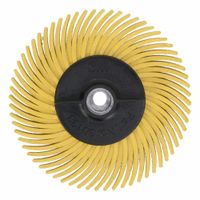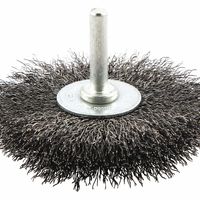Call +(254) 703 030 000 / 751 483 999 / 721 704 777
- Home
- Abrasives
- Abrasive Brushes
- Wire Wheel Brushes
.....Read More
Frequently Asked Questions
What are the safety precautions when using wire wheel brushes on rotary tools?
When using wire wheel brushes on rotary tools, several safety precautions are essential to prevent accidents and ensure effective operation:
1. **Personal Protective Equipment (PPE):** Always wear safety goggles or a face shield to protect your eyes from flying debris. Use gloves to protect your hands from sharp wires and wear a dust mask if working with materials that produce dust.
2. **Inspect the Brush:** Before use, inspect the wire wheel brush for any damage, such as loose wires or cracks. A damaged brush can disintegrate during operation, posing a hazard.
3. **Secure the Workpiece:** Ensure the workpiece is securely clamped or held in place to prevent movement during operation, which can lead to loss of control.
4. **Tool Compatibility:** Verify that the wire wheel brush is compatible with the rotary tool, including the correct size and speed rating. Using a brush at a higher speed than recommended can cause it to break apart.
5. **Proper Installation:** Ensure the brush is properly mounted on the tool, following the manufacturer's instructions. An improperly mounted brush can wobble or detach during use.
6. **Work Area Safety:** Keep the work area clean and free of clutter. Ensure adequate lighting and ventilation to maintain visibility and air quality.
7. **Safe Operation:** Maintain a firm grip on the tool and use both hands if possible. Avoid applying excessive pressure, which can cause the brush to wear out quickly or the tool to kick back.
8. **Avoid Loose Clothing:** Do not wear loose clothing, jewelry, or long hair that could get caught in the rotating brush.
9. **Regular Maintenance:** Regularly check and maintain the rotary tool and brush to ensure they are in good working condition.
10. **Emergency Preparedness:** Be aware of emergency procedures and have a first aid kit readily available in case of an accident.
How do I choose the right wire wheel brush for my project?
To choose the right wire wheel brush for your project, consider the following factors:
1. **Material Compatibility**: Match the wire material to the workpiece. Use carbon steel brushes for ferrous metals and stainless steel or brass brushes for non-ferrous metals to prevent contamination and corrosion.
2. **Wire Type**:
- **Crimped Wire**: Suitable for light to medium-duty applications, providing a softer brushing action.
- **Knotted Wire**: Ideal for heavy-duty applications, offering aggressive cleaning and deburring.
3. **Wire Diameter**: Thicker wires are more aggressive and durable, suitable for heavy-duty tasks. Thinner wires are less aggressive, ideal for fine surface finishing.
4. **Brush Diameter and Width**: Larger diameters cover more surface area quickly, while smaller diameters are better for precision work. Choose the width based on the area size you need to cover.
5. **RPM Rating**: Ensure the brush's maximum RPM rating matches or exceeds the tool's speed to prevent accidents and ensure efficiency.
6. **Arbor Size**: Match the brush's arbor hole size to your tool's spindle size for proper fit and operation.
7. **Application Type**: Determine the task—cleaning, deburring, surface preparation, or finishing—and select a brush designed for that specific purpose.
8. **Tool Compatibility**: Ensure the brush is compatible with your power tool, whether it's a bench grinder, angle grinder, or drill.
9. **Safety Considerations**: Choose brushes with safety features like protective guards or shrouds if necessary, and always wear appropriate personal protective equipment (PPE).
By evaluating these factors, you can select a wire wheel brush that meets the specific requirements of your project, ensuring efficiency, safety, and optimal results.
Can wire wheel brushes be used on all types of materials?
Wire wheel brushes are versatile tools used for cleaning, deburring, and surface preparation. However, they are not suitable for all types of materials.
1. **Metals**: Wire wheel brushes are commonly used on metals like steel, iron, and aluminum. They effectively remove rust, paint, and corrosion without significantly damaging the metal surface. However, softer metals like aluminum require careful handling to avoid surface damage.
2. **Wood**: While wire wheel brushes can be used on wood, they can be too aggressive, potentially gouging or scratching the surface. For wood, softer bristle brushes or sanding might be more appropriate.
3. **Plastics**: Wire wheel brushes are generally not recommended for plastics. The abrasive nature of the wire can easily damage or melt the plastic surface due to frictional heat.
4. **Glass and Ceramics**: These materials are too brittle for wire wheel brushes. The hard wires can cause scratches or even shatter the material.
5. **Composites**: Similar to plastics, composites can be damaged by the aggressive action of wire wheel brushes. The fibers and resins in composites can be torn or abraded.
In summary, while wire wheel brushes are effective for many metal surfaces, they are not universally suitable for all materials. Careful consideration of the material's hardness and brittleness is essential to avoid damage.
What is the difference between wire wheel brushes and radial bristle discs?
Wire wheel brushes and radial bristle discs are both tools used for surface preparation, cleaning, and finishing, but they differ in construction, material, and application.
Wire wheel brushes consist of metal wires, typically made from steel, stainless steel, or brass, that are twisted or crimped into a wheel shape. They are mounted on power tools like grinders or drills. Wire wheel brushes are used for heavy-duty applications such as rust removal, deburring, and cleaning welds. They are effective on hard surfaces and can remove tough contaminants. However, they can be aggressive and may damage softer materials.
Radial bristle discs, on the other hand, are made from flexible plastic bristles embedded with abrasive grains. These discs are designed to be used with rotary tools and are available in various grit sizes. Radial bristle discs are suitable for more delicate tasks, such as polishing, light deburring, and surface finishing. They are less aggressive than wire wheel brushes and are ideal for use on softer materials like aluminum, plastic, and wood. The flexibility of the bristles allows them to conform to the surface, providing a more uniform finish without gouging.
In summary, the primary differences lie in their construction and application: wire wheel brushes are made of metal wires for heavy-duty tasks on hard surfaces, while radial bristle discs use abrasive-embedded plastic bristles for more delicate work on softer materials.
How do I properly install a wire wheel brush on a rotary tool?
To properly install a wire wheel brush on a rotary tool, follow these steps:
1. **Safety First**: Ensure the rotary tool is unplugged or the battery is removed to prevent accidental activation. Wear safety goggles and gloves to protect against wire bristles and debris.
2. **Select the Right Brush**: Choose a wire wheel brush compatible with your rotary tool. Check the shank size to ensure it fits the tool's collet or chuck.
3. **Prepare the Tool**: If your rotary tool has a collet, use the provided wrench to loosen the collet nut. If it has a chuck, open it by turning the chuck key or by hand if it's a keyless chuck.
4. **Insert the Brush**: Insert the shank of the wire wheel brush into the collet or chuck. Ensure it is seated fully and straight to prevent wobbling during operation.
5. **Secure the Brush**: Tighten the collet nut using the wrench or close the chuck securely. Ensure the brush is firmly held in place and does not move when gently tugged.
6. **Check Alignment**: Spin the brush by hand to ensure it rotates freely without wobbling. Adjust if necessary by loosening and repositioning the brush.
7. **Test Run**: Plug in the tool or reattach the battery. Turn on the rotary tool at a low speed to test the brush's stability. Gradually increase the speed while observing for any imbalance or excessive vibration.
8. **Operation**: Once satisfied with the installation, proceed with your task. Maintain a firm grip on the tool and apply light pressure to avoid damaging the workpiece or the brush.
9. **Maintenance**: Regularly inspect the brush for wear and replace it when the bristles become too short or damaged.
How do I maintain and clean wire wheel brushes for longevity?
To maintain and clean wire wheel brushes for longevity, follow these steps:
1. **Regular Inspection**: Frequently check the wire wheel brush for any signs of wear, such as broken wires or uneven bristle length. Replace the brush if it shows significant damage to prevent accidents and ensure effective performance.
2. **Proper Storage**: Store the wire wheel brush in a dry, clean area to prevent rust and corrosion. Avoid placing heavy objects on top of it to maintain its shape and integrity.
3. **Cleaning After Use**: After each use, clean the brush to remove debris and residue. Use a stiff-bristled brush or compressed air to dislodge particles trapped between the wires. Avoid using water or solvents that can cause rust.
4. **Avoid Overloading**: Do not apply excessive pressure during use, as this can cause the wires to bend or break prematurely. Let the brush do the work by applying light, consistent pressure.
5. **Use Appropriate Speed**: Operate the wire wheel brush at the recommended speed. Excessive speed can lead to rapid wear and potential safety hazards, while too low a speed may reduce cleaning efficiency.
6. **Lubrication**: Occasionally, apply a light machine oil to the hub of the brush to ensure smooth operation and reduce friction, which can extend the life of the brush.
7. **Balanced Use**: Use the entire surface of the brush evenly to prevent uneven wear. Rotate the brush periodically to ensure all areas are used equally.
8. **Safety Gear**: Always wear appropriate safety gear, such as goggles and gloves, to protect against flying debris and accidental contact with the brush.
By following these maintenance and cleaning practices, you can extend the life of your wire wheel brushes and ensure they remain effective for various applications.
What are the common applications for wire wheel brushes in metalworking?
Wire wheel brushes are versatile tools commonly used in metalworking for a variety of applications. They are primarily employed for surface preparation, cleaning, and finishing tasks. Here are some of the common applications:
1. **Rust and Paint Removal**: Wire wheel brushes are effective in removing rust, old paint, and corrosion from metal surfaces. They help in preparing the metal for further treatment or painting by ensuring a clean surface.
2. **Deburring**: After cutting or machining metal, burrs or sharp edges can remain. Wire wheel brushes are used to smooth out these edges, ensuring a safer and more finished product.
3. **Surface Cleaning**: These brushes are used to clean metal surfaces by removing dirt, grease, and other contaminants. This is crucial before welding or applying coatings to ensure proper adhesion.
4. **Weld Cleaning**: Post-welding, wire wheel brushes are used to clean weld seams. They remove slag, spatter, and discoloration, improving the appearance and quality of the weld.
5. **Polishing and Finishing**: Wire wheel brushes can be used to achieve a desired surface finish on metal parts. They can create a uniform texture or shine, depending on the type of wire and brush used.
6. **Edge Blending**: In metal fabrication, wire wheel brushes help in blending edges and corners, ensuring a smooth transition between surfaces.
7. **Scale Removal**: In processes like forging or heat treating, scale can form on metal surfaces. Wire wheel brushes are used to remove this scale, preparing the metal for further processing.
8. **Texturing**: For decorative purposes, wire wheel brushes can be used to create specific textures on metal surfaces, enhancing the aesthetic appeal of the final product.
These applications make wire wheel brushes indispensable in metalworking, contributing to both the functionality and aesthetics of metal products.




